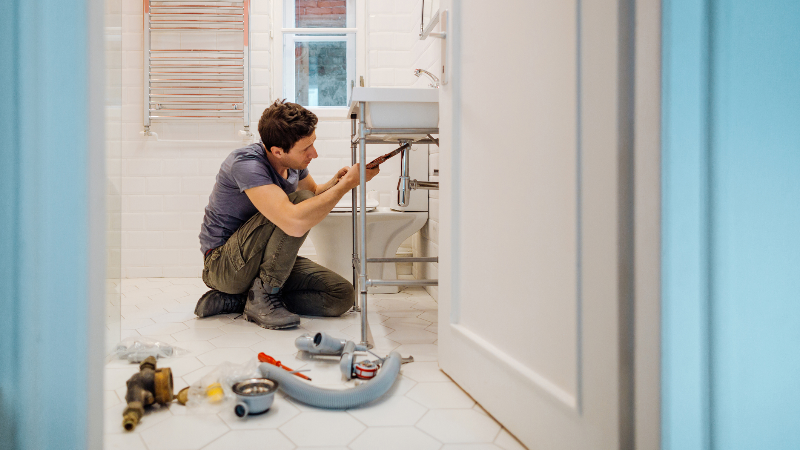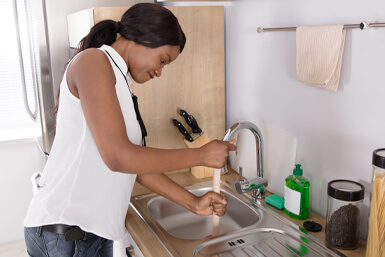Everyone will have his or her own conception when it comes to Why Do My Pipes Make Noises.

To identify noisy plumbing, it is very important to figure out initial whether the undesirable audios happen on the system's inlet side-in other words, when water is transformed on-or on the drainpipe side. Noises on the inlet side have differed reasons: excessive water pressure, used shutoff and tap parts, improperly attached pumps or various other devices, improperly placed pipeline bolts, as well as plumbing runs containing a lot of tight bends or other restrictions. Sounds on the drainpipe side usually originate from bad location or, similar to some inlet side sound, a layout having tight bends.
Hissing
Hissing noise that takes place when a tap is opened slightly usually signals extreme water stress. Consult your regional public utility if you presume this problem; it will certainly be able to inform you the water pressure in your area as well as can install a pressurereducing shutoff on the incoming water pipe if essential.
Thudding
Thudding noise, usually accompanied by shuddering pipelines, when a faucet or device shutoff is shut off is a problem called water hammer. The noise and also vibration are triggered by the reverberating wave of stress in the water, which suddenly has no location to go. Sometimes opening a shutoff that releases water rapidly right into a section of piping consisting of a restriction, arm joint, or tee installation can create the very same condition.
Water hammer can normally be cured by setting up installations called air chambers or shock absorbers in the plumbing to which the problem shutoffs or taps are connected. These gadgets allow the shock wave produced by the halted circulation of water to dissipate airborne they contain, which (unlike water) is compressible.
Older plumbing systems might have brief vertical sections of capped pipe behind wall surfaces on faucet runs for the exact same objective; these can eventually full of water, lowering or destroying their efficiency. The remedy is to drain pipes the water supply completely by turning off the major water supply valve as well as opening up all faucets. Then open up the major supply shutoff and close the taps individually, starting with the faucet nearest the valve as well as finishing with the one farthest away.
Babbling or Screeching
Intense chattering or shrieking that takes place when a shutoff or faucet is turned on, and that normally goes away when the installation is opened fully, signals loose or faulty interior components. The service is to replace the shutoff or tap with a brand-new one.
Pumps and also appliances such as washing devices as well as dishwashing machines can move electric motor sound to pipelines if they are poorly attached. Link such items to plumbing with plastic or rubber hoses-never rigid pipe-to isolate them.
Other Inlet Side Noises
Creaking, squeaking, scraping, snapping, as well as tapping normally are triggered by the growth or tightening of pipelines, normally copper ones providing warm water. The noises happen as the pipelines slide versus loose fasteners or strike close-by home framing. You can typically identify the place of the problem if the pipes are exposed; just follow the sound when the pipelines are making sounds. More than likely you will certainly uncover a loosened pipe hanger or a location where pipelines exist so near flooring joists or various other mounting pieces that they clatter against them. Attaching foam pipe insulation around the pipelines at the point of contact should remedy the trouble. Be sure bands and also wall mounts are protected and give appropriate assistance. Where possible, pipeline bolts ought to be attached to substantial structural components such as structure walls as opposed to to mounting; doing so minimizes the transmission of vibrations from plumbing to surface areas that can magnify and move them. If connecting bolts to framework is unavoidable, cover pipes with insulation or various other durable material where they call fasteners, and also sandwich the ends of brand-new fasteners between rubber washing machines when installing them.
Remedying plumbing runs that struggle with flow-restricting limited or various bends is a last resort that must be carried out just after speaking with a knowledgeable plumbing specialist. Unfortunately, this circumstance is fairly common in older homes that might not have been constructed with indoor plumbing or that have actually seen several remodels, particularly by beginners.
Drainpipe Sound
On the drain side of plumbing, the principal objectives are to get rid of surface areas that can be struck by falling or rushing water and also to insulate pipelines to contain inevitable audios.
In new building, tubs, shower stalls, toilets, as well as wallmounted sinks and also basins ought to be set on or versus resilient underlayments to minimize the transmission of sound through them. Water-saving toilets as well as taps are less noisy than standard models; install them as opposed to older kinds even if codes in your area still permit making use of older components.
Drainpipes that do not run up and down to the cellar or that branch into horizontal pipeline runs supported at flooring joists or various other framing present especially frustrating noise problems. Such pipelines are huge sufficient to radiate considerable vibration; they additionally lug significant amounts of water, which makes the circumstance even worse. In brand-new construction, specify cast-iron soil pipelines (the huge pipelines that drain pipes toilets) if you can afford them. Their massiveness consists of a lot of the sound made by water travelling through them. Additionally, avoid routing drainpipes in walls shown bed rooms as well as areas where individuals collect. Wall surfaces containing drains should be soundproofed as was described earlier, using double panels of sound-insulating fiberboard as well as wallboard. Pipes themselves can be wrapped with special fiberglass insulation produced the function; such pipes have an invulnerable plastic skin (often consisting of lead). Results are not always acceptable.
WHY IS MY PLUMBING MAKING SO MUCH NOISE?
This noise indeed sounds like someone is banging a hammer against your pipes! It happens when a faucet is opened, allowed to run for a bit, then quickly shut — causing the rushing water to slam against the shut-off valve.
To remedy this, you’ll need to check and refill your air chamber. Air chambers are filled with — you guessed it — air and help absorb the shock of moving water (that comes to a sudden stop). Over time, these chambers can fill with water, making them less effective.
You’ll want to turn off your home’s water supply, then open ALL faucets (from the bathroom sink to outdoor hose bib) to drain your pipes. Then, turn the water back on and hopefully the noise stops! If you’re still hearing the sound, give us a call to examine further.
Whistles
Whistling sounds can be frustrating, as sometimes the source isn’t easily identified. However, if you can pinpoint which faucet or valve that may be the cause, you’ll likely encounter a worn gasket or washer — an easy fix if you replace the worn parts!Whistling sounds from elsewhere can mean a number of things — from high water pressure to mineral deposits. Your best plan of attack here is to give our plumbing experts a call. We’ll be able to determine where the noise is coming from and what the cause may be, then recommend an effective fix!
Cracks or Ticks
Cracking or ticking typically comes from hot water going through cold, copper pipes. This causes the copper to expand resulting in a cracking or ticking sound. Once the pipes stop expanding, the noise should stop as well.
Pro tip: you may want to lower the temperature of your water heater to see if that helps lessen the sound, or wrapping the pipe in insulation can also help muffle the noise.
Bangs
Bangs typically come from water pressure that’s too high. To test for high water pressure, get a pressure gauge and attach it to your faucet. Water pressure should be no higher than 80 psi (pounds per square inch) and also no lower than 40 psi. If you find a number greater than 80 psi, then you’ve found your problem!
Next step is to give us a call in order to install a pressure regulator. Trust us, you don’t want to wait to resolve this issue. Not only is the sound annoying, but high water pressure can be destructive to your home — including damaging certain appliances, like your washer and dishwasher.
Dripping
You might be accustom to the slow quiet drip your kitchen faucet makes. You might have even tuned out your bathroom sink dripping and drabbing all day long — but it’s time to find its cause.
A slow drip could signify a variety of easy to fix issues, such as a worn out O ring, or loose part. And by ignoring the drip, you could be wasting up to 2,000 gallons of water a year! So start conserving water — get it looked at ASAP.
https://www.pwessig.com/blog/2018/december/why-is-my-plumbing-making-so-much-noise-/

We had been brought to that editorial on Why is My Home Making Strange Plumbing Noises through an associate on another blog. Sharing is good. Helping others is fun. Thank you for your time. Visit again soon.
Book My Estimate